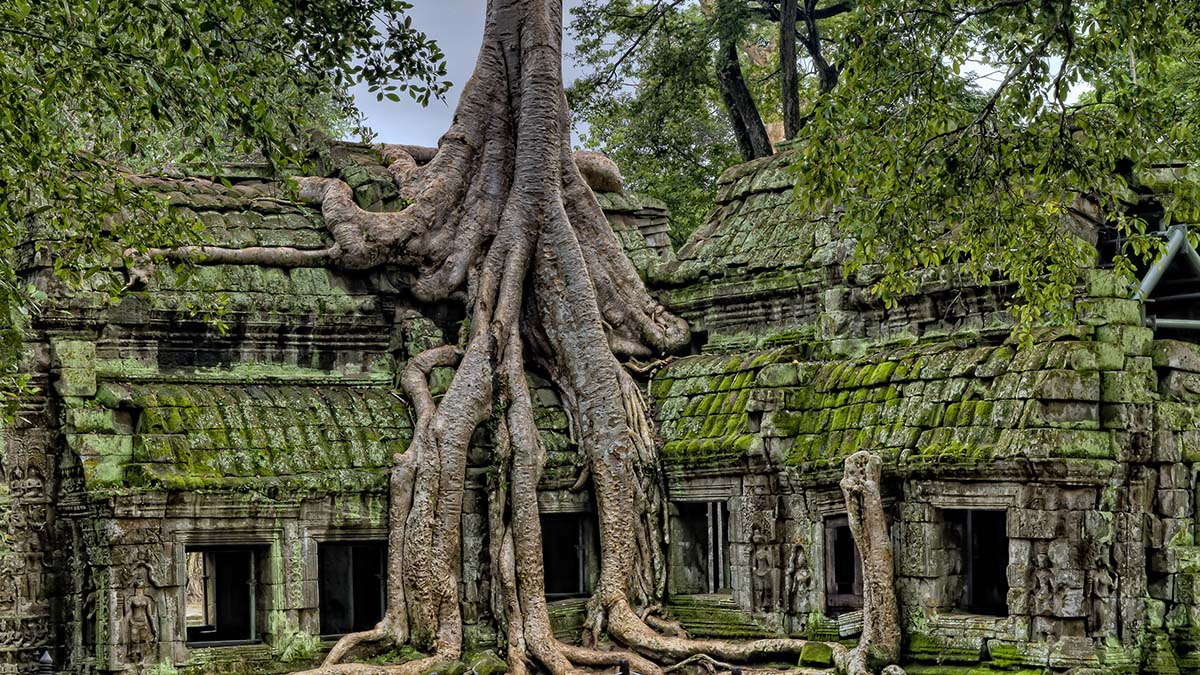
Angkor Wat, Siem Reap, Cambodia
by Lee Beavington
The full moon hangs low. Voluminous clouds shroud us in darkness as we ride toward Cambodia’s ancient Angkor temples, and the world’s largest religious monument. The open sides of the tuk-tuk (essentially a motorcycle pulling a covered cart, in which my girlfriend Jen and I sit) allow us to breathe in the cool, tropical air, a far cry from the stifling midday heat. Our nine-temple itinerary convinced us to wake at a bleary-eyed 4:30 am.
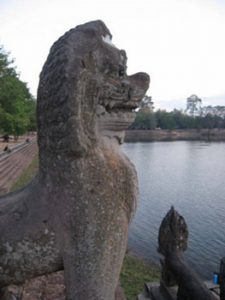 We catch a glimpse of moonlight shimmering on Angkor Wat’s monstrous moat, which holds enough water to fill a thousand swimming pools. The tuk-tuk rumbles past the hordes of tourists, all armed with cameras in pursuit of a perfect temple sunrise. We head toward a less traveled destination: Srah Srang. Dug out nearly a thousand years ago, the 700 by 350 meter “pool of ablutions” once served as bathing grounds for Angkorian royalty.
We catch a glimpse of moonlight shimmering on Angkor Wat’s monstrous moat, which holds enough water to fill a thousand swimming pools. The tuk-tuk rumbles past the hordes of tourists, all armed with cameras in pursuit of a perfect temple sunrise. We head toward a less traveled destination: Srah Srang. Dug out nearly a thousand years ago, the 700 by 350 meter “pool of ablutions” once served as bathing grounds for Angkorian royalty.
The tuk-tuk comes to a grinding stop. Between the masked moon and the now dimmed tuk-tuk headlight, we find ourselves staring into pitch black. A girl’s voice suddenly breaks the sacred quiet of the sanctuary.
“You want coffee?”
Touts are commonplace outside every temple, born out of third world tourism, and always with something in hand to flog. “You want tea? Or maybe a shirt? Trousers? Books?”
We negotiate our way through darkness and touts to the water’s edge. A dozen other tourists are scattered around the sandstone terrace. Elephantine steps lead down to the tranquil lake, while life-size lion statues sit regally beside us, their stoic stares awaiting the first reflections of dawn. Pale light fills the overcast sky.
We turn, and suddenly face our first truly spectacular sight of the day: on the opposite horizon, the full moon is setting above the elaborate stone-carved gateway to Banteay Kdei. Absorbed by the veiled sunrise, I didn’t notice the archway with its huge face in the rock gazing back at me. Passing beneath the entrance—large enough to accommodate an elephant—feels like passing through a time portal. Built around 1300 during the reign of King Jayavarman VII, the crumbling Buddhist monastery still retains its original masonry—countless corridors and bas-relief carvings.
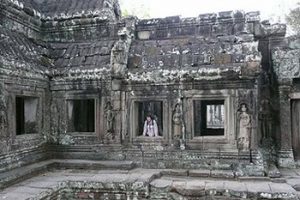 For centuries Buddhists roamed these halls; some still do, as evidenced by the sugary incense shedding smoke over cross-legged Buddhas. Most walls hold carved Bodhi leaves and ornamental flowers, outlining sculptures of sensual apsara dancers and peculiar creatures from Hindu mythology: Garuda, a man with the head of a bird, and his mortal enemy Naga, the giant, multi-headed serpent with a cobra hood. In Cambodia’s past, Hinduism supplanted Buddhism, at least for a time, so their respective sculptures merge and overlap in most Angkor temples. The exotic, entrancing stonework never seems to end, and the sun creeps well toward noon before we depart.
For centuries Buddhists roamed these halls; some still do, as evidenced by the sugary incense shedding smoke over cross-legged Buddhas. Most walls hold carved Bodhi leaves and ornamental flowers, outlining sculptures of sensual apsara dancers and peculiar creatures from Hindu mythology: Garuda, a man with the head of a bird, and his mortal enemy Naga, the giant, multi-headed serpent with a cobra hood. In Cambodia’s past, Hinduism supplanted Buddhism, at least for a time, so their respective sculptures merge and overlap in most Angkor temples. The exotic, entrancing stonework never seems to end, and the sun creeps well toward noon before we depart.
“Ta Prohm,” we tell our tuk-tuk driver.
He nods, and we shield our faces from the dust as we speed toward the next temple on our agenda, and the highlight of our two weeks in Cambodia. On foot again, we cross the threshold of another imposing entry tower (called a gopura, meaning “gate with a face”) and flash our pass at the guard. We make our way to the root-ridden central sanctuary. A dozen stone towers materialize amongst the tapestry of green and yellow foliage.
“Oh my god,” Jen remarks, a common refrain at Ta Prohm. “Oh my god.”
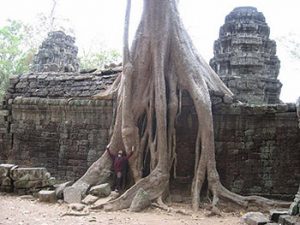 Most of the Angkor temples have been cleared of curious vines and invasive trees. But here, tropical jungle has run amok, transforming Ta Prohm into a living exhibition of man versus nature. The temple’s four concentric walls are riddled with visible roots belonging to century-old silk-cotton and strangler figs. Their spiderweb branches stretch well above the tallest towers. From a seed that found a patch of viable soil atop the laterite walls, tentacle-like roots – some of which are thicker than me – reach down through the crevices of masonry, dislodging huge cubic stones.
Most of the Angkor temples have been cleared of curious vines and invasive trees. But here, tropical jungle has run amok, transforming Ta Prohm into a living exhibition of man versus nature. The temple’s four concentric walls are riddled with visible roots belonging to century-old silk-cotton and strangler figs. Their spiderweb branches stretch well above the tallest towers. From a seed that found a patch of viable soil atop the laterite walls, tentacle-like roots – some of which are thicker than me – reach down through the crevices of masonry, dislodging huge cubic stones.
I find a secluded spot to sit and absorb the magnificent display. The eroded wall next to me leans precariously to one side, like oversized lego blocks placed by a toddler’s hand. Part of the upper half has already toppled, so I can see the detached, individual stones used in Ta Prohm’s construction. Each of these huge grey bricks are far too large for even four men to carry. I am lost in wonderment, inspired and humbled by humankind’s remarkable and resolute mind. Only the ants marching over the slabs of rock, an endless highway of workers, show a comparable determination to create such vast empires. I think of the thousands of Khmers who laid down this temple’s foundation in 1186, all as a tribute to Jayavarman’s mother, the former Queen.
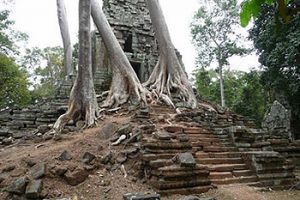 From there, we visit the three-tiered pyramid of Pre Rup, and then the vast complex of Preah Kahn, wandering the vaulted corridors of the antiquated Buddhist university. But it is the ancient city of Angkor Thom that demands a more thorough exploration.
From there, we visit the three-tiered pyramid of Pre Rup, and then the vast complex of Preah Kahn, wandering the vaulted corridors of the antiquated Buddhist university. But it is the ancient city of Angkor Thom that demands a more thorough exploration.
Here, the monuments and shrines are ubiquitous. It takes a hundred steps to follow the continuous hunting scene sculpted in stone along the elephant terrace. Phimeanakas, the royal palace, resides high above a daunting set of steep, shallow steps that only accommodate feet placed sideways.
Jen squints to see the top. “I am not climbing that.”
“We’ll find a way,” I say. And we do. I feel like Indiana Jones on the most elaborate set ever constructed.
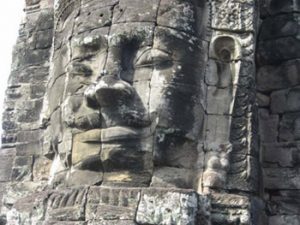 The shaded and peaceful Preah Palilay, a solitary tower with huge trees growing like stubborn pillars right out of the crumbling foundation, is the perfect place to awaken everyone’s inner Buddha. And then I spot the countless face-towers of the Bayon.
The shaded and peaceful Preah Palilay, a solitary tower with huge trees growing like stubborn pillars right out of the crumbling foundation, is the perfect place to awaken everyone’s inner Buddha. And then I spot the countless face-towers of the Bayon.
From afar, the Bayon resembles a pile of unexciting, lichen-clad ruins. Upon closer inspection, I realize the temple is watching me from all sides. The thirty-seven preserved towers rise up above a labyrinth of dark chambers, arched corridors and treacherous stairways; colossal stone faces stare impassively from each, usually in all four cardinal directions, their original emotions long since eroded. The stoic gaze of King Jayavarman follows my every step. Is he welcoming me? Or cursing me for trespassing? “Angkor Wat?” our tuk-tuk driver inquires when we return.
I nod. We’ve saved the biggest and boldest for last.
Angkor Wat was originally a Hindu temple, lost for centuries and rediscovered in 1860 by French adventurers. Of course, the Cambodians knew it was there all along. The temple has infiltrated almost every aspect of their culture, from the flag and currency to t-shirts and the national beer.
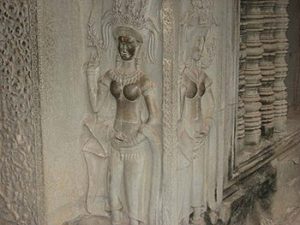 Our tuk-tuk driver yields to a train of oncoming elephants. Soon Angkor Wat’s five summit towers become visible over the high tree line. The main causeway of this grandiose 12th century temple holds hundreds of people, stretching across a moat with a six-kilometre perimeter. Inside the main complex, endless arrays of bas-relief narratives showcase creation myths, historic processions, and godly battles. Everywhere I look, another marvel: nearly 2,000 carefully carved apsaras. I want to touch one of those smooth, weathered bodies of stone, but stay my hand in order to preserve the feminine curves for future generations. Where countless others have touched them for good luck, statue faces, bellies and breasts are blackened by skin oils.
Our tuk-tuk driver yields to a train of oncoming elephants. Soon Angkor Wat’s five summit towers become visible over the high tree line. The main causeway of this grandiose 12th century temple holds hundreds of people, stretching across a moat with a six-kilometre perimeter. Inside the main complex, endless arrays of bas-relief narratives showcase creation myths, historic processions, and godly battles. Everywhere I look, another marvel: nearly 2,000 carefully carved apsaras. I want to touch one of those smooth, weathered bodies of stone, but stay my hand in order to preserve the feminine curves for future generations. Where countless others have touched them for good luck, statue faces, bellies and breasts are blackened by skin oils.
Macaque monkeys scurry up the central temple-mountain, their lithe, tailed bodies silhouetted by the darkening sky. The gathered crowd roars at their amorous antics. Overwhelmed by the sheer immensity of the place, I crane my neck and gaze upward in awe at towers that have stood in solitude for almost a millennium. Within the gargantuan walls of this grandest of creations, I feel like an ant from a visiting colony, very small and very out of place. Yet I don’t want to leave. I am shaken by the audacity of humankind to conceive and construct such a monument. To haul huge masses of sandstone from the distant Kulen Mountains, stack them into structures both imposing and reverential, and meticulously carve every available surface is a testament to our species’ tenacious drive to create.
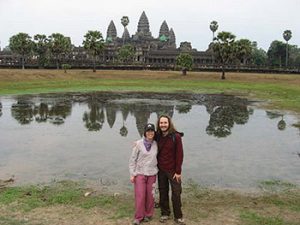 On our way out, the sun hugs the horizon. We stand in front of the south pool and a willing fellow tourist snaps a shot of Angkor Wat reflected above us in the calm waters. We thank him and venture back to our hotel in Siem Reap, utterly spent.
On our way out, the sun hugs the horizon. We stand in front of the south pool and a willing fellow tourist snaps a shot of Angkor Wat reflected above us in the calm waters. We thank him and venture back to our hotel in Siem Reap, utterly spent.
As I drift off to sleep that night, I see a vision of the day’s first temple – Banteay Kdei – recalling it as I walked through its grand gopura under the light of the full moon. Truly one of the wonders of the world, the temple ruins are a rare opportunity for an up-close, hands-on travel through time.
If You Go:
Cambodians speak English in all the major towns. Despite the lack of a language barrier, the oft-smiling Cambodians certainly appreciate hearing thank you (“awkun”) in their native Khmer.
Pick up a copy of the remarkably informative Ancient Angkor by Claude Jacques (available in English and French). It retails for about $30, but you can find it in Siem Reap for $5 US.
Currency: Cambodian Riel. However, US dollars are readily accepted nearly everywhere in Cambodia. $1 USD = approximately 4000 KHR. Many hotels and restaurants take credit cards. Have small cash on hand to pay tuk-tuk drivers and vendors selling water and snacks.
Best time to go: Late November to February. The rainy season runs from June to October. April is the hottest month, when temperatures soar over 40 degrees Celsius. However, the average daytime temperature stays above 30 degrees year-round, making a hat, sunscreen and light clothing all essential items.
How to get there: Fly in through the capital, Phnom Penh. An air conditioned bus from Phnom Penh to Siem Reap (a five hour ride) costs under $10. Siem Reap is ten minutes south of the Angkor temple ruins. This bustling river town has its own airport, which is an option for a shorter trip just to see the temples. Accommodation: Accommodation is available in Siem Reap, which includes hot water, fridge and air conditioning for under $15 a night, although you may have to put up with mosquitoes and ants.
Visiting the Temples: A day is simply not enough to see all of Angkor. Passes can be bought for a single day ($20), three days ($40) or a week ($60). The fittest travellers can rent a bicycle to get around, but that makes for an exhausting day, especially with the heat. Your best bet is to hire a tuk-tuk driver, who will drive you around from sunrise to sunset for a mere $12. Also, an English guide can be hired for $25 a day.
Other Attractions near Angkor Wat: Kbal Spean, home to a number of amazing riverbed carvings, is about an hour’s tuk-tuk ride from the main temples. The standard tuk-tuk fare seems to be $28. In Siem Reap, the quiet and modern Buddhist temple Wat Bo offers a respite from the busy city. Hundreds of shrieking fruit bats hang out in the trees near the Royal Gardens, which many people seem to miss. The Artisans d’Angkor workshop is also worth a visit, to see how traditional stone and wooden carvings are made, and the Old Market (Psar Chaa) is a hub for shopping, where every imaginable item can be haggled for – if you can handle the pandemonium.
For More Information:
Wikipedia: Angkor Wat
UNESCO: Angkor
Angkor Wat Tours Now Available:
Half Day Private Splendour of Angkor Wat Cultural Tour
Full-Day Private Discovery Tour of Angkor Complex from Siem Reap
Angkor Wat Helicopter Flight with Private Tour of Temples
Private Tour: Angkor Wat and The Royal Temples Full-Day Tour from Siem Reap
About the author:
Lee Beavington works as a biology lab instructor at Kwantlen University College in BC. In the past two years, he has traveled to India, Sri Lanka, Kenya, Iceland, Cambodia and South Korea. He writes in many genres, including memoir, science fiction and flash, and had a novella published in Writers of the Future XXII.
Writing website: www.leebeavington.com
Travel blog: http://leeodyssey.blogspot.com/
Contact: lee@leebeavington.com
Photo credits:
First Angkor temple tree photo by James Wheeler on Unsplash
All other photos are by Lee Beavington / Jennifer Burgess.

